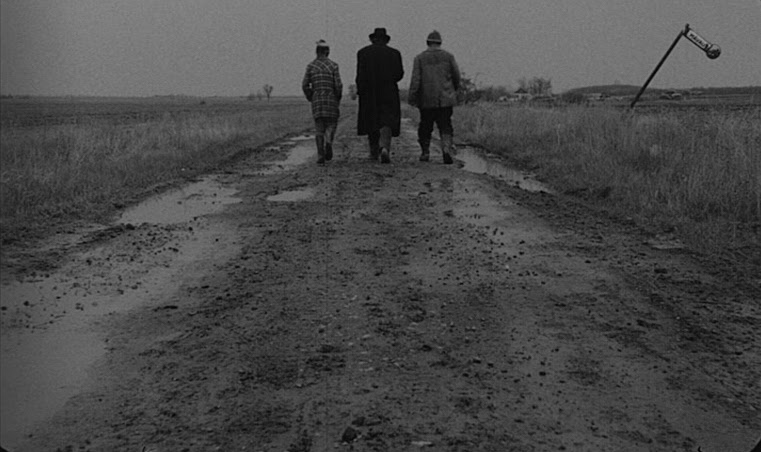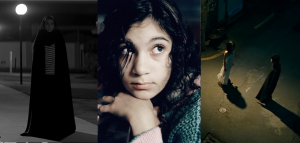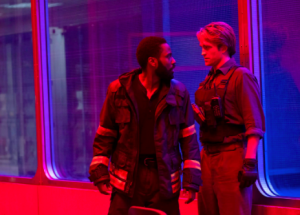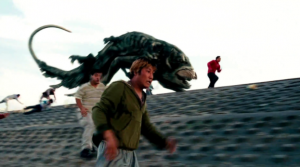“Sátántangó” (1994): A lens held to the eye of the devil
Sanyi (András Bodnár), Irimiás (Mihály Víg), and Petrina (Putyi Horváth) walking down one of many endless muddy roads in “Sátántangó”. Image courtesy of Filmgrab.
November 14, 2020
Author’s Note: I don’t think I have the capacity to do this movie justice, but with the coming 4K restoration of the film, I felt this was the only time I’d be able to try.
“Sátántangó” is, in my humble opinion, one of the few truly transcendent film experiences. It doesn’t, nay, could never function like a normal movie. Nothing with a seven hour runtime can. But “Sátántangó” is wholly gripping, completely engrossing, in a way that you just don’t see in anything else. The near apocalyptic wasteland of post-Soviet Hungary is drab, hopeless, and indescribably beautiful. Director Béla Tarr crafts a world so intensely engrossing that even long scenes where little happens demand your attention. This film’s utterly oppressive existence will knock you down, submerging you in its desolate atmosphere until you can finally experience the meteoric heights of what the cinematic medium can achieve.
“Sátántangó” is a Hungarian film that follows the stories of various villagers in a small farming settlement after they learn that two men previously thought dead, Irimiás and Petrina, are coming to town. The film is split into 12 chapters (with intermissions after chapters 3 and 6). The first six are devoted to the day before their arrival, and the second six chronicle the days afterward. We follow the events of the first day from just about every perspective possible. There’s Futaki and the Schmidts, who want to scam all of the other villagers out of a year’s worth of pay; the Doctor, who wastes away in his house drinking cheap booze and watching everyone else; and a myriad of other characters with their own lives and hangups. The reason the film can chronicle the days of so many characters in the first half of the movie is, of course, its obscene 432 minute runtime, close to four and a half hours of which comprise the first six chapters.
The only way that something like this could work is through truly exceptional writing and pacing, which this movie has in spades. Each character is rich and interesting, and the existential fear that Irimiás and Petrina instill in the villagers is immediately interesting. Each character is given time to breathe, and the intimacy with which you see their lives is incredibly immersive. You see every detail of their muddy, barren, eternally rainy world, and it’s palpably depressing knowing that the characters’ have accepted this bleak existence for lack of any better options. What keeps this movie going is that it’s mostly atmosphere, with long stretches of time often serving only to show another dilapidated building or moldy crevice the townspeople call home. Somehow though, “Sátántangó” can get away with this through sheer cinematic mastery.
While “Sátántangó” is certainly excellently written and acted, what sets it apart from just about any other movie ever made is its pure, unbridled filmmaking. The cinematography can only be described as mesmerizing. The camera ebbs and flows through glacially paced long takes with the grace of an omnipotent being, remaining intimate yet unsympathetic to the poor denizens of this hellscape. Tarr seems to have control over the very landscape and weather, with meticulous composition after meticulous composition. There’s personality in every corner of this horrible world, and the camera holds on each shot long enough for you to notice it, but never so long that it hurts the pace.
Complimenting “Sátántangó’s” towering visual mastery is its oppressive soundscape. The rain is constant, the wind is harsh, and oftentimes you’ll hear every breath coming out of a character’s mouth. The sound design is so subtly immersive that, along with the visuals, you can never divert your attention, even in seemingly uneventful scenes. The film mostly refrains from using music, but when it does, it hits hard. Apart from one bar tune, composer Mihály Vig (Who also played Irimiás) created a score which elevates whatever scene it’s in to mythic heights, leading to some of the most powerful scenes in the history of cinema.
“Sátántangó” is monumental, a testament of the unique potential of cinematic storytelling. It weaves together existential melancholy and overwhelming beauty in a way that I’ve never seen done before or since. This film comes closer than any other I’ve seen to inciting a religious experience in me, and I could easily see myself watching this every year for the rest of my life. It’s not only one of the greatest movies of all time, but possibly one of the finest pieces of art ever created by man. I understand if you don’t think you would ever watch it. I understand if you think I’m just another pretentious nob trying to get you to see an art film. But if you have the wherewithal to sit down and watch the entirety of this behemoth, I guarantee that you’ll be treated to a cinematic experience like no other. You can preorder the new 4K Restoration of “Sátántangó” on Blu-ray right now, and you can stream it on Kanopy and The Criterion Channel.










Ashley • Dec 6, 2020 at 10:43 pm
Nicely written!